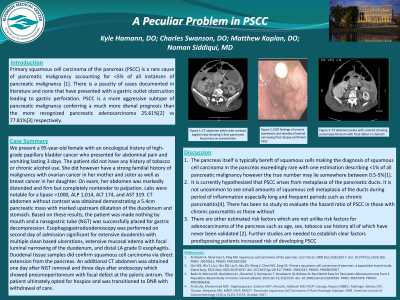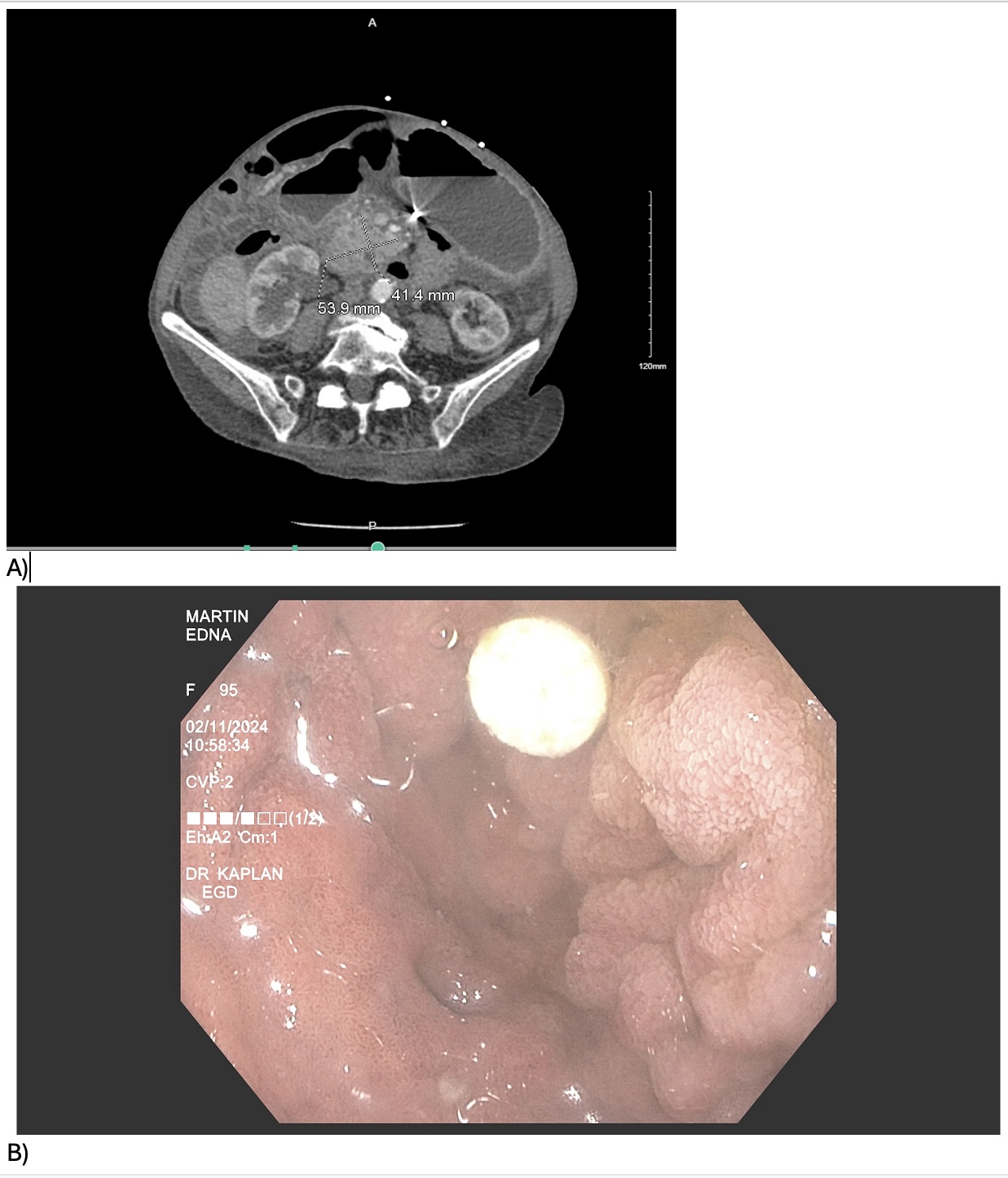Tuesday Poster Session
Category: Biliary/Pancreas
P3501 - A Peculiar Problem in PSCC
Tuesday, October 29, 2024
10:30 AM - 4:00 PM ET
Location: Exhibit Hall E

Has Audio

Kyle Hamann, DO
Riverside Medical Center
Kankakee, IL
Presenting Author(s)
Kyle Hamann, DO1, Charles Swanson, DO1, Matthew Kaplan, DO2
1Riverside Medical Center, Kankakee, IL; 2Digestive Disease Consultants, Bourbonnais, IL
Introduction: Primary squamous cell carcinoma of the pancreas (PSCC) is a rare cause of pancreatic malignancy accounting for < 5% of all instances of pancreatic malignancy. There is a paucity of cases documented in literature and none that have presented with a gastric outlet obstruction leading to gastric perforation. PSCC is a more aggressive subtype of pancreatic malignancy with a one-year survival rate of roughly 12% similar to the 5-year survival rate of pancreatic adenocarcinoma.
Case Description/Methods: We present a 95-year-old female with an oncological history of high-grade papillary bladder cancer who presented for abdominal pain and vomiting lasting 3 days. The patient did not have any history of tobacco or chronic alcohol use. She did however have strong familial history of malignancy with ovarian cancer in her mother and sister as well as breast cancer in her daughter. On exam, her abdomen was markedly distended and firm but nontender to palpation. Labs were notable for a lipase >1000, ALP 1,014, ALT 174, and AST 319. CT abdomen w/ contrast was obtained demonstrating a 5.4cm pancreatic mass with marked upstream dilatation of the duodenum and stomach. Based on these results, the patient was made nothing by mouth and a nasogastric tube (NGT) was successfully placed for gastric decompression. Esophagogastroduodenoscopy was performed day 2 significant for extensive duodenitis with multiple clean based ulcerations, extensive mucosal edema with focal luminal narrowing of the duodenum, and distal LA grade D esophagitis. Duodenal tissue samples did confirm squamous carcinoma via extension from the pancreas. An additional CT abdomen was obtained one day after NGT removal on day 4 and showed pneumoperitoneum with focal defect at the pyloric antrum. The patient ultimately opted for hospice and was transitioned to DNR with withdrawal of care.
Discussion: This case represents a unique complication of a rare pancreatic malignancy. It is theorized that PSCC arises from squamous metaplasia on the pancreatic ducts as the pancreas is typically bereft of squamous cells. Gastric perforation in PSCC is yet another dreaded complication of an already aggressive subtype of pancreatic cancer that has yet to be reported. PSCC carries a high mortality rate with a mere 3-month prognosis. Currently, there are no causative factors that have been clearly identified further complicating the difficulty to prevent this entity.

Disclosures:
Kyle Hamann, DO1, Charles Swanson, DO1, Matthew Kaplan, DO2. P3501 - A Peculiar Problem in PSCC, ACG 2024 Annual Scientific Meeting Abstracts. Philadelphia, PA: American College of Gastroenterology.
1Riverside Medical Center, Kankakee, IL; 2Digestive Disease Consultants, Bourbonnais, IL
Introduction: Primary squamous cell carcinoma of the pancreas (PSCC) is a rare cause of pancreatic malignancy accounting for < 5% of all instances of pancreatic malignancy. There is a paucity of cases documented in literature and none that have presented with a gastric outlet obstruction leading to gastric perforation. PSCC is a more aggressive subtype of pancreatic malignancy with a one-year survival rate of roughly 12% similar to the 5-year survival rate of pancreatic adenocarcinoma.
Case Description/Methods: We present a 95-year-old female with an oncological history of high-grade papillary bladder cancer who presented for abdominal pain and vomiting lasting 3 days. The patient did not have any history of tobacco or chronic alcohol use. She did however have strong familial history of malignancy with ovarian cancer in her mother and sister as well as breast cancer in her daughter. On exam, her abdomen was markedly distended and firm but nontender to palpation. Labs were notable for a lipase >1000, ALP 1,014, ALT 174, and AST 319. CT abdomen w/ contrast was obtained demonstrating a 5.4cm pancreatic mass with marked upstream dilatation of the duodenum and stomach. Based on these results, the patient was made nothing by mouth and a nasogastric tube (NGT) was successfully placed for gastric decompression. Esophagogastroduodenoscopy was performed day 2 significant for extensive duodenitis with multiple clean based ulcerations, extensive mucosal edema with focal luminal narrowing of the duodenum, and distal LA grade D esophagitis. Duodenal tissue samples did confirm squamous carcinoma via extension from the pancreas. An additional CT abdomen was obtained one day after NGT removal on day 4 and showed pneumoperitoneum with focal defect at the pyloric antrum. The patient ultimately opted for hospice and was transitioned to DNR with withdrawal of care.
Discussion: This case represents a unique complication of a rare pancreatic malignancy. It is theorized that PSCC arises from squamous metaplasia on the pancreatic ducts as the pancreas is typically bereft of squamous cells. Gastric perforation in PSCC is yet another dreaded complication of an already aggressive subtype of pancreatic cancer that has yet to be reported. PSCC carries a high mortality rate with a mere 3-month prognosis. Currently, there are no causative factors that have been clearly identified further complicating the difficulty to prevent this entity.

Figure: A)Transverse view CT abdomen pelvis w/ contrast demonstrating 53.9mm x 41.4mm pancreatic head mass
B)Luminal narrowing of duodenum seen on esophagogastroduodenoscopy
B)Luminal narrowing of duodenum seen on esophagogastroduodenoscopy
Disclosures:
Kyle Hamann indicated no relevant financial relationships.
Charles Swanson indicated no relevant financial relationships.
Matthew Kaplan indicated no relevant financial relationships.
Kyle Hamann, DO1, Charles Swanson, DO1, Matthew Kaplan, DO2. P3501 - A Peculiar Problem in PSCC, ACG 2024 Annual Scientific Meeting Abstracts. Philadelphia, PA: American College of Gastroenterology.
